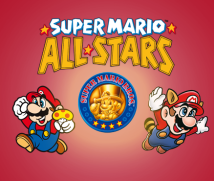2. The New Guys, Too!
See how it says “ojama” (obstacle) in a picture of the screen in the first specifications?
Yeah, there were "obstacles" back then, not "enemies." I remember we used that term when we shifted the arcade version of Donkey Kong 6 over to the Famicom. Originally it was "things that get in the way." 6 Donkey Kong: An arcade game that appeared in 1981. The Family Computer System (Famicom) version was released in 1983 in Japan.
We called them “ojamamushi” (nuisances). But once, when interpreting to overseas staff, someone asked what kind of an insect (mushi) an ojamamushi is. It was a serious question, and I had no idea how to answer.
(laughs)
They translated it as "obstacle."
Or “shogaibutsu” in Japanese. Thanks to Nakago-san holding on to all this stuff, we can learn a lot even 25 years later. (laughs)
Earlier we talked about flying. Here are the specs from that time.
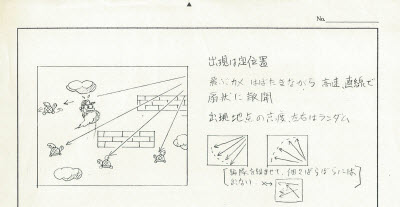
Hmm, at this point it's not a rocket that he's riding, but a cloud. About when was this written? There's no stamp with the date.
This was later than the first specs.
This looks like Tezuka-san's drawing.
Yeah. There's no date, so it's probably mine.
Ah, that shows your personality. (laughs)
(laughs)
Tezuka-san was a new guy back then, but he said whatever he wanted, like, "I want to fly around the sky on a cloud." I'd say, "Well then draw it!"
And this is what resulted.
Even though we ended up not using it.
Tezuka-san, you joined Nintendo in April of 1984, the year after the Famicom came out.
Yeah. I joined the same time as Kondo-san.
You're peers.
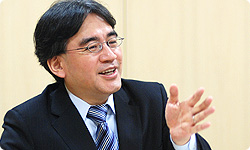
Yeah.
Super Mario Bros. was completed your second year at the company, so when the first plans were drawn up, you two were still new guys in your first year.
Right.
Yeah.
Back then, before Tezuka-san came, I was doing all the design work myself, so it was a big help just to have another designer. (laughs) When they joined, I was partway through Devil World 7, so I had them help me with that. 7 Devil World: An action game released for the Family Computer System (Famicom) in October 1984 in Japan.
So Devil World was Tezuka-san's debut work?
I think he was assistant director.
Yes. I was a helper.
Was Devil World also your debut, Kondo-san?
Yes.
After that, Nakago-san and I worked together making Excitebike .8 I had Tezuka-san polish up the art I did, and we started in on Kung-Fu9, but Tezuka-san... 8 Excitebike: A side-view racing game released for the Family Computer System (Famicom) in November 1984 in Japan. 9 Kung-Fu: An action game released for the Family Computer System (Famicom) in June 1985 in Japan.
I didn't do anything for Kung-Fu.
I helped out a little.
You helped out with the sound effects, right?
Yes.
By the way, were you originally supposed to work on music when you joined Nintendo?
Yes. I was hired along with one other person to be the first music staff.
You were our first music team.
Yeah. But there were some before us, like Hirokazu Tanaka10, who did music along with programming. 10 Hirokazu Tanaka: Hirokazu Tanaka worked at Nintendo as a composer and was responsible for the music for many titles, including Balloon Fight, Dr. Mario and EarthBound. He is currently the president of Creatures Inc.
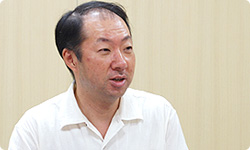
Before, the technology personnel also made the music. I, too, made sound effects during the Famicom's early age, even though today it's unimaginable. (laughs) Did the idea naturally arise within the company that music specialists were necessary? Or did you push for that, Miyamoto-san?
I think some other people were saying that too, but around the time of Donkey Kong, we didn't have anyone but Tanaka-san who could write music, so I was often talking about how we'd be in trouble if we didn't get any sound specialists. And I said that in the coming years we would definitely need, not just musicians, but designers as well.
That was just when specialisation was picking up.
Yeah. After Kung-Fu, we started making Super Mario Bros., and I appointed Kondo-san to sound.
You thought Kondo-san was right for the job. Why was that?
He made a song for Devil World's bonus screen, and I thought that attitude was really great.
A song for Devil World? (laughs)
Yeah. Kondo-san thought up the tune, and Tezuka-san wrote some lyrics. I thought, "They're nice, so let's put them in the instruction booklet!"
Because they were nice. (laughs)
It was really fun to have young guys come into the company and to work with them.
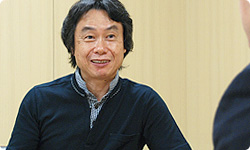
Is the musical notation for Devil World still around?
The lyrics are around somewhere, but...
On the bonus screen, there's a song that goes ♪da-dum-da-dum da-dum-da-dum, and the words go, "♪This one? That one? Which one?" .
(laughs)
I've heard that. (laughs)
Writing words for video game music and including the notation and lyrics in the instruction booklet wasn't something anyone was doing back then, so I was all for it.
No one was doing it, so you encouraged the new guys to. You encouraged the new guys to do it by saying no one else was doing it.
But unfortunately, that never got put in. (laughs)
(laughs)
